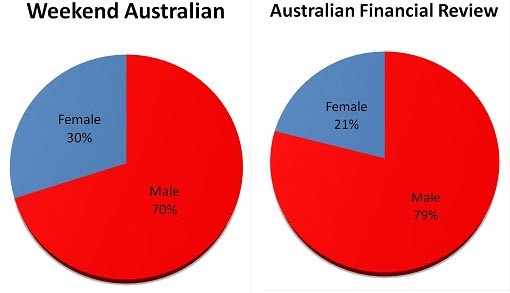Last year, the US-based group VIDA — created to promote women in the literary arts — released these bright red and blue pie charts showing how many women and men were reviewed in, or wrote for, various high-profile literary publications during 2010. The response was much soul searching the literary world over. In Australia the release of the figures was quickly followed by an all-male shortlist (of three) for the 2011 Miles Franklin award. The combination of these facts led to plenty of discussion and ultimately, the establishment of the Stella Prize for women’s writing.
Come 2012 and VIDA has released “the count” for 2011 — and the pies haven’t changed all that much. Honourable mentions go to the Boston Review and Granta, dishonourable mention to the New York Review of Books (seven female authors reviewed, 293 male authors reviewed). But what about Australia?
So far, there has been some anecdotal discussion of how our local publications measure up in the equality stakes, but little in the way of figures. Bookseller+Publisher collects data on book mentions in Australia’s print media around the country each week, so we thought we’d perform our own count.
A note on the data, before we get to the pies: for our count we have looked at books reviewed in several national publications and at least one major paper in each state during 2011. Each week we also collect mentions of books in feature articles or profiles, but since these can be incidental we’re concentrating on reviews where the book mentioned is the main game. As with any process where a human is taking hard copy print data and transferring it to a database, there is the chance of the occasional error. We would dearly love some of these percentages to be proved wrong; however, we think it’s unlikely that the trends for these publications could be greatly altered by one or two typos on our part.
Finally, it is worth noting who has been championing (or at least equally recognising) books by women: The Daily Telegraph, the Sunday Territorian, the Sunday Tasmanian, Good Reading, the West Australian and The Sunday Age. (It seems women writers are more palatable on a Sunday.) You can see who deserves a dishonourable mention for yourself below …
National:




New South Wales:

Victoria:


Queensland:

Australian Capital Territory:

South Australia:

Tasmania:

Western Australia:

*The article was first published at Bookseller+Publisher







This is interesting and shows that presence of mind is needed to ensure that the pool of writers available is as broad, diverse and representative as possible, while also meeting the needs of the particular publication and its readers. At Griffith REVIEW we have made a deliberate effort to try to ensure this by keeping the pathways as open as possible – mixing the established names with newcomers. We are pleased to report that triggered by this study we have analysed our published contributors from 2011 and found that the split was 61% female to 39 % male.
Surely reviewers would not choose books based on gender, but I guess that’s what this article is suggesting? Maybe most reviewers are men and are drawn to topics which are more often covered by men authors? If that’s the case then maybe we should have more female reviewers rather than consciously select books based on the gender of the author.
I have a Sunday AGE book review column, and when I did a rough census re book author gender last year, over a five month period, I actually came up a lot higher for female representation. I then compared notes with a SMH reviewer, and she got precisely 50:50.
Lucy Sussex
This is really interesting. I don’t think anyone is suggesting that either reviewers or editors consciously discriminate against women writers (“Rule #1: Never review a book by a chick”), but it does seem, when the numbers are are stark as they appear to be, that there must be some underlying structural reasons why books by women authors are under-represented in major publications.
I am a complete outsider to the whole process of book reviewing, so I would like to see more qualitative exploration of the issue, particularly from the perspective of people involved in the review process. Namely, how does an editor go about selecting which books are to be reviewed? What factors are considered? Are some genres considered inherently more worthy of reviewing than others? I am interested in Julianne Schultz’s comment that Griffith REVIEW makes a conscious effort to review books by “newcomers” – is this the case with all publications? And what is the role of publishers in this?
Also, related – how big a “deal” is a review in a mainstream paper in generating book sales? Presumably, it is more important for debut authors, and for niche categories, perhaps literary fiction? And how much does the valence of the review matter? Is it (as I suspect) better to be reviewed negatively than not at all, particularly if you are a debut author?
@Lucy: If you’re a debut author, you should be writing for Kindle, exclusively, until you get known. And get someone, anyone really, to edit it before you publish, because of all the reviews I see on Kindle, the one that really puts me off is negative comments about spelling, grammar, and the like. Another thing to like about Kindle is that the reviewers get reviewed. Mainstream paper reviewers seem too precious to accept criticism but are happy to dish it out.